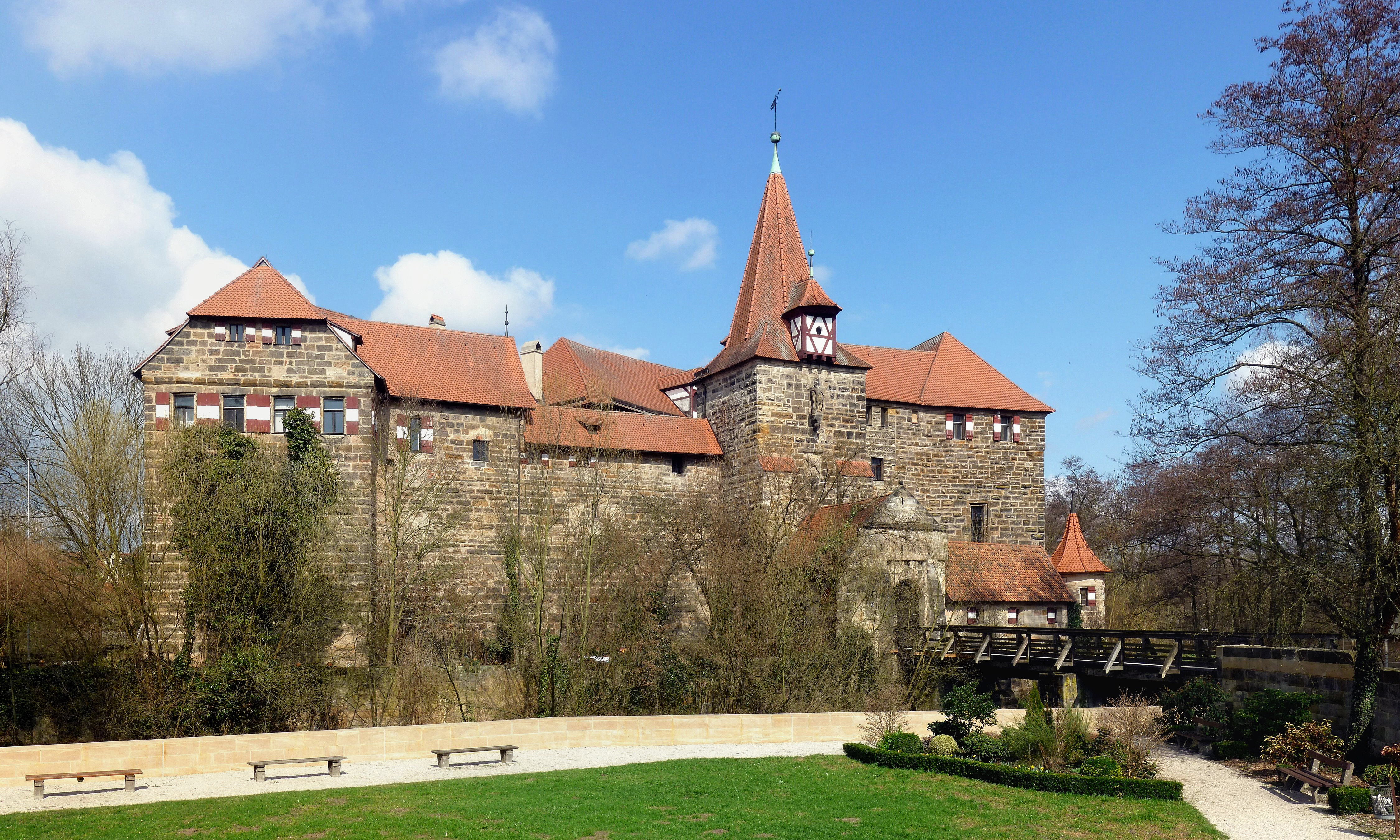Lauf Castle on:
[Wikipedia]
[Google]
[Amazon]
 Lauf Castle (german: Wenzelschloss or ''Burg Lauf''; cs, hrad Lauf) was originally a medieval fortress in the town of
Lauf Castle (german: Wenzelschloss or ''Burg Lauf''; cs, hrad Lauf) was originally a medieval fortress in the town of Lauf an der Pegnitz: Jaký bude další osud erbovní klenotnice Českého království? (What Will Be Next Fate of the Bohemian Kingdom's Armorial Treasury?)
Lauf laid in an area called the
Wappensaal. Wasserschloss Lauf an der Pegnitz
– depiction of Lauf's armorial hall {{Authority control Castles in Bavaria Registered historic buildings and monuments in Bavaria
 Lauf Castle (german: Wenzelschloss or ''Burg Lauf''; cs, hrad Lauf) was originally a medieval fortress in the town of
Lauf Castle (german: Wenzelschloss or ''Burg Lauf''; cs, hrad Lauf) was originally a medieval fortress in the town of Lauf an der Pegnitz
Lauf an der Pegnitz (; Northern Bavarian: ''Lauf an da Pegnitz'') is a town to the East of Nuremberg, Germany. It is the capital of the district Nürnberger Land, in Bavaria. It is in the valley of the River Pegnitz, which flows through the tow ...
near Nuremberg
Nuremberg ( ; german: link=no, Nürnberg ; in the local East Franconian dialect: ''Nämberch'' ) is the second-largest city of the German state of Bavaria after its capital Munich, and its 518,370 (2019) inhabitants make it the 14th-largest ...
, Germany
Germany,, officially the Federal Republic of Germany, is a country in Central Europe. It is the second most populous country in Europe after Russia, and the most populous member state of the European Union. Germany is situated betwe ...
. The German name ''Wenzelschloss'' ("Saint Wenceslas' Chateau") is derived from to the present day surviving statue of Saint Wenceslas
Wenceslaus I ( cs, Václav ; c. 907 – 28 September 935 or 929), Wenceslas I or ''Václav the Good'' was the Duke ('' kníže'') of Bohemia from 921 until his death, probably in 935. According to the legend, he was assassinated by his younger ...
, patron saint
A patron saint, patroness saint, patron hallow or heavenly protector is a saint who in Catholicism, Anglicanism, or Eastern Orthodoxy is regarded as the heavenly advocate of a nation, place, craft, activity, class, clan, family, or perso ...
of Czechs
The Czechs ( cs, Češi, ; singular Czech, masculine: ''Čech'' , singular feminine: ''Češka'' ), or the Czech people (), are a West Slavic ethnic group and a nation native to the Czech Republic in Central Europe, who share a common ancestry, ...
, on the facade of the entrance gate. The castle was built by the Charles IV, Holy Roman Emperor in 1356, on the way between Prague
Prague ( ; cs, Praha ; german: Prag, ; la, Praga) is the capital and List of cities in the Czech Republic, largest city in the Czech Republic, and the historical capital of Bohemia. On the Vltava river, Prague is home to about 1.3 milli ...
and Nuremberg
Nuremberg ( ; german: link=no, Nürnberg ; in the local East Franconian dialect: ''Nämberch'' ) is the second-largest city of the German state of Bavaria after its capital Munich, and its 518,370 (2019) inhabitants make it the 14th-largest ...
on the ruins of an older castle. The dominant feature of the castle is the hall of arms; in 1934, under a layer of old paint were discovered 112 coats of arms of noblemen of the Crown of Bohemia
The Lands of the Bohemian Crown were a number of incorporated states in Central Europe during the medieval and early modern periods connected by feudal relations under the Bohemian kings. The crown lands primarily consisted of the Kingdom of Bo ...
. It is the most precious collection of Bohemian, Moravia
Moravia ( , also , ; cs, Morava ; german: link=yes, Mähren ; pl, Morawy ; szl, Morawa; la, Moravia) is a historical region in the east of the Czech Republic and one of three historical Czech lands, with Bohemia and Czech Silesia.
The m ...
n and Silesia
Silesia (, also , ) is a historical region of Central Europe that lies mostly within Poland, with small parts in the Czech Republic and Germany. Its area is approximately , and the population is estimated at around 8,000,000. Silesia is split ...
n secular and ecclesiastical heraldry.Lauf laid in an area called the
Bohemian Palatinate
The Bohemian Palatinate ( cs, Česká Falc) or Bohemian Upper Palatinate (german: Böhmische Oberpfalz), since the 19th century also called New Bohemia ( cs, Nové Čechy, german: Neuböhmen), is a historical area in the northeast of present-day B ...
, which was once part of the Bohemian crown lands. In 1373 Emperor Charles IV ceded the castle along with parts of the Bohemian Palatinate to Otto V, Duke of Bavaria
Otto V (''c.'' 1340 – 15 November 1379), was a Duke of Bavaria and Elector of Brandenburg as Otto VII. Otto was the fourth son of Holy Roman Emperor Louis IV by his second wife Margaret II of Avesnes, Countess of Hainaut and Holland.
Bio ...
in exchange for the Margraviate of Brandenburg
The Margraviate of Brandenburg (german: link=no, Markgrafschaft Brandenburg) was a major principality of the Holy Roman Empire from 1157 to 1806 that played a pivotal role in the history of Germany and Central Europe.
Brandenburg developed out ...
. Charles' son Wenceslaus IV lost the rest of the Palatinate in 1401.
References
External links
Wappensaal. Wasserschloss Lauf an der Pegnitz
– depiction of Lauf's armorial hall {{Authority control Castles in Bavaria Registered historic buildings and monuments in Bavaria